
Welcome to the next day of tide pooling, this time on the north side of Fogarty Creek Beach, still in Depoe Bay. Where we are standing, you would normally see us about three or four feet below the ocean’s surface, but through the magic of planet rotation and the way tides work, we and all the sea life around us are out in the open air. Good for us, not so great for life that depends on living in water. Something else that’s different: we woke to a foggy coast.

Just in case you had difficulty identifying those colorful speckled dots in the first photo, they are sea stars. We no longer call them starfish because the idiots among us were confusing these invertebrates with those things that have gills, tails, fins, and other stuff that make fish fish. Strangely enough, sea stars are related to sand dollars, sea urchins, and, most peculiarly, sea cucumbers.

This crab must have thought he was the cock of the walk and immune from the gulls while he strutted his stuff like he was still under ten feet of water. That was until the seven Mennonite girls from California decided the crab needed prodding by their feet to make it do tricks. Caroline swept in, grabbed the “toy” from the young ladies, and put it in a nearby pool where it could regain its crabby senses.

Slurp, guzzle, crunch as another mussel bites the dust, I mean the everted stomach that intruded into a shell to liquefy breakfast.

I tasked Caroline to identify an area she felt best represented an average-density location of crustaceans. Her job was to count, to the best of her ability, the individuals per square meter (ind/m²) – she’s German and still knows the metric system better than our idiotic Imperial system of measurement nonsense. Using a quadrat sampling system she had learned in grade school, she came up with a number that suggests that there were approximately 800 animals per square meter. Then, isolating this part of the shore using an app that tells us the total surface area of a delineated space marked by coordinates we sent in using our phone’s GPS coordinates, we were able to determine that this 150-meter by 40-meter cluster of rocks with a total surface area of 36,000 square meters is holding about 28,800,000 mollusks and invertebrates, not counting tiny baby mussels, sea stars, and barnacles that were too small to include in our rapid count. Considering that an average mussel weighs 25 grams, a barnacle about 3.5 grams, and a sea star 300 grams, and considering their ratio on these rocks, we derived the total weight of creatures before us as at an incredible 1,749,570 kilograms, of which under 272,155 kilos are edible.

Obviously, this wall of six chitons and the less-than-ideal density of barnacles skews our figures and wrecks the nutritional value calculations we were considering sharing in the next photo.

This is a testament to how far out to sea the low tide has allowed us to venture: it’s common knowledge that sea palm kelp only grows at depths of 100 feet or more below sea level. It’s a safe bet to say we could be a mile deep.

Proof that we are more than a mile below the normal surface of the ocean.
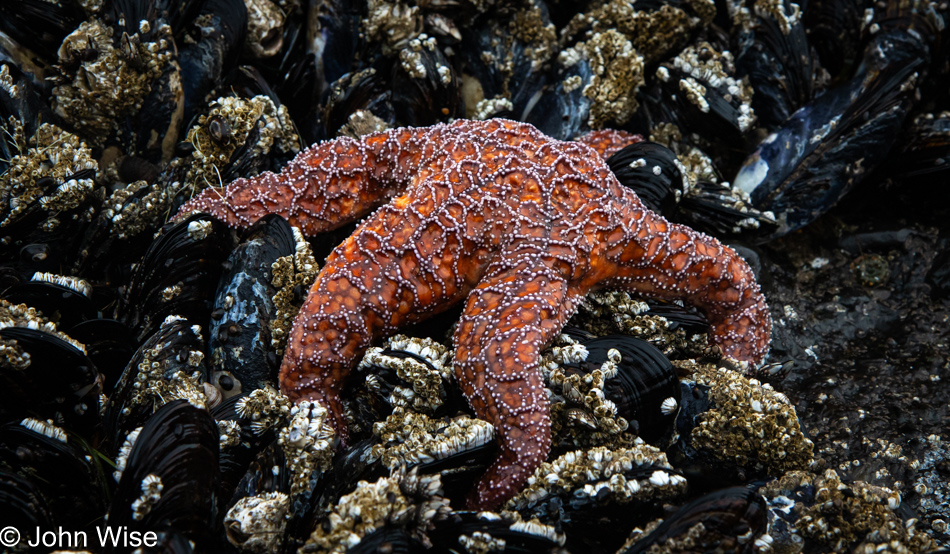
Munch, nosh, glug, and gargle.
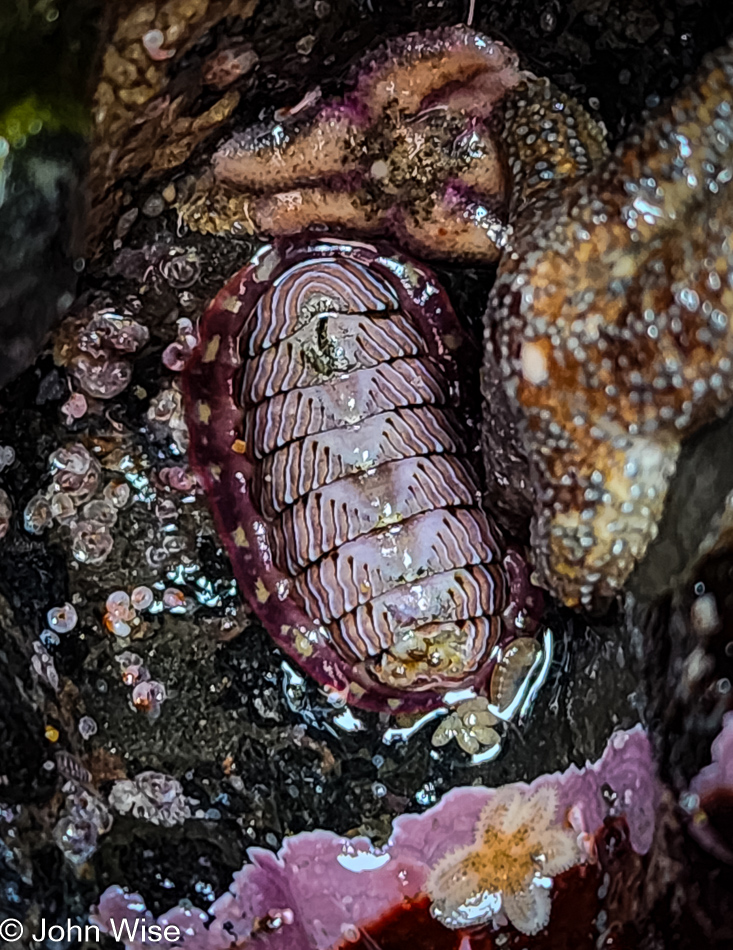
Yesterday, I presented the last part of the day with black & white photos; this image and the three below are the results of using an advanced digital potato to capture sea life that would have otherwise not been witnessed by my readers. You see, DSLR cameras like my trusty Canon T7i were not built to operate under extreme conditions such as these depths, while the Samsung Android S22 can perform down here. Sure, they are mediocre photos, but consider the rarity of seeing the seldom-captured lined chiton. This specimen was only about 3cm long.
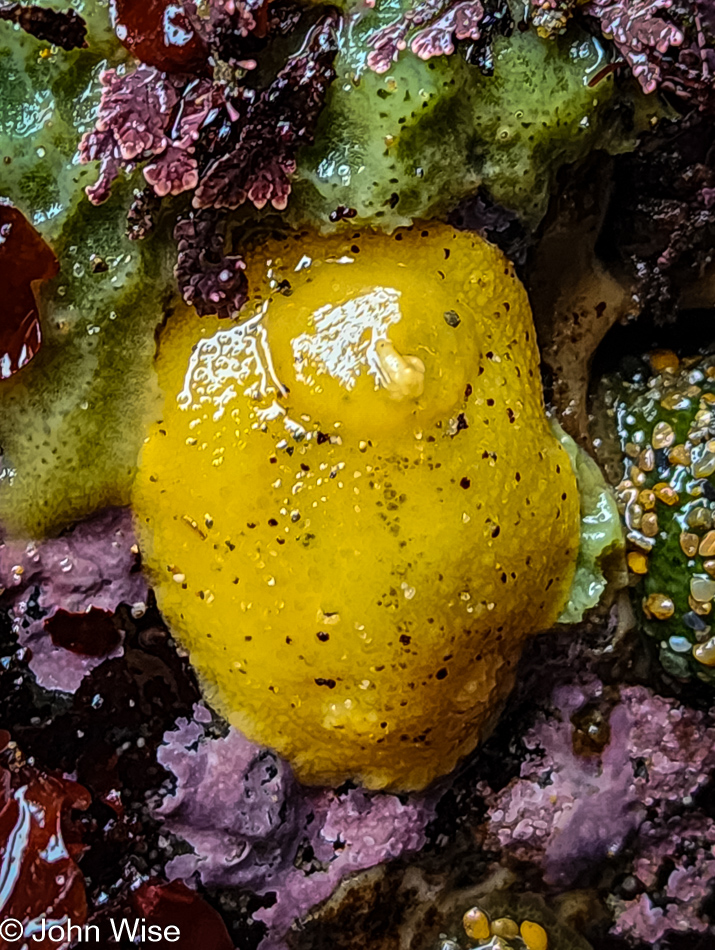
The rare yellow oblique-sea slug. My apologies for peppering it before photographing it; I was about to pop this baby into my gullet…after first everting my stomach. While carefully studying the sea stars, I might have learned a valuable lesson from this creature we shared our last common ancestor with about 550-600 million years ago. If our distant ancestors could do it, so can I.
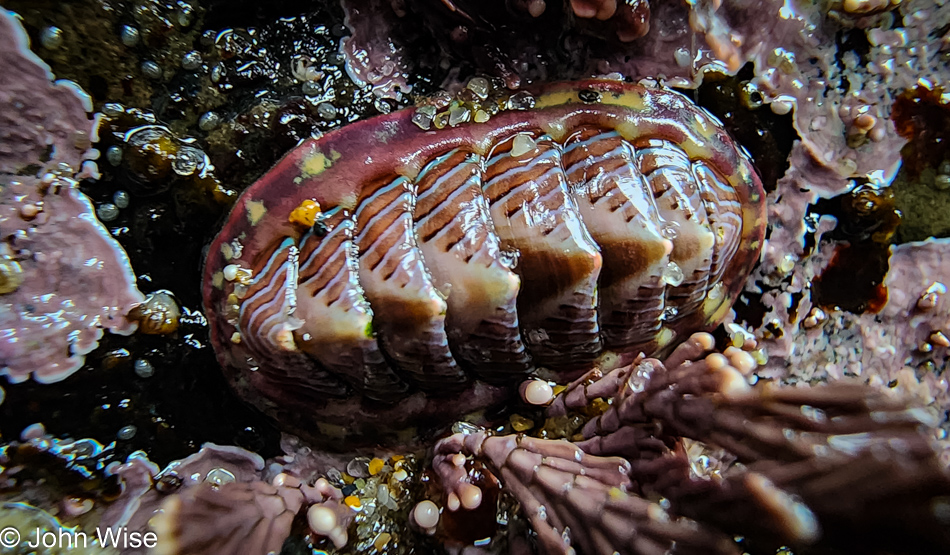
If you think I turned the image of the other Lined chiton into landscape mode, you must doubt my integrity.
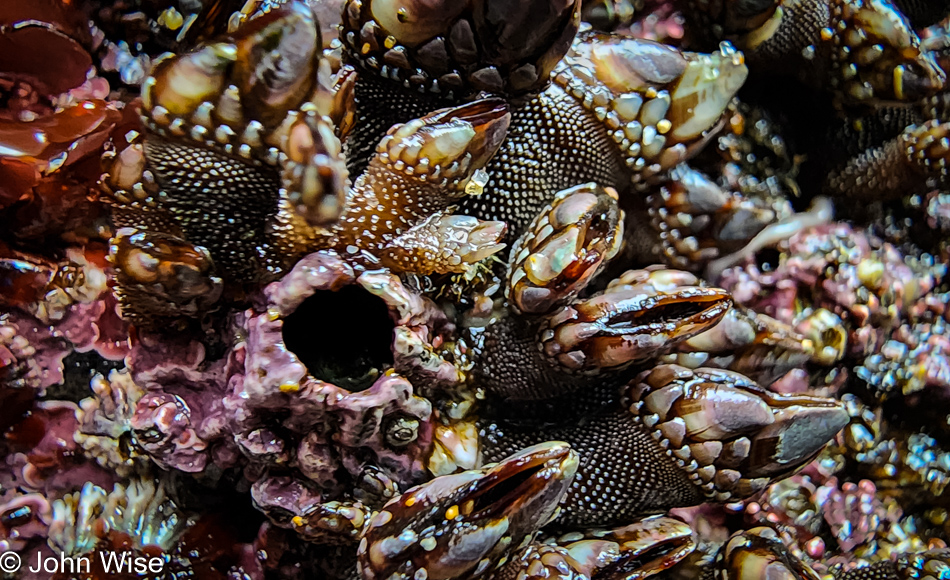
This is a jewel display at Poseidon’s version of a Tiffany store. About now, I’m seriously considering my next incarnation and think coming back as a gooseneck barnacle wouldn’t be a bad thing. I attach myself to some coral or rock for a life among the sea’s treasures and thrust out my cirri to catch whatever food is passing me by, and it’s all free. Don’t confuse the cirri with a penis; the former are feather-like appendages composed of six pairs of jointed, hair-like structures used for capturing plankton and other small sea life. Speaking of penis, while it wouldn’t be as bizarrely long as my acorn barnacle relatives’ tool of manhood, when it does loll out of my peduncle, it would still be long enough to visit my neighbors: life would be good.

I think I might be obsessed with barnacles.
Later that day, I was reading something else about barnacles due to the more exotic, possibly very old gooseneck barnacles we saw over at the Devils Punchbowl. They were dead and seriously long (photo below), but in identifying them, I came across an article from iNaturalist.org with a footnote credit to “American Heritage Dictionary. Retrieved 2011-12-04,” about the origins of the word barnacle, and it was too interesting not to include:
In thirteenth-century England the word “barnacle” was used for a species of waterfowl, the barnacle goose (Branta leucopsis). This bird breeds in the Arctic, but winters in the British Isles so its nests and eggs were never seen by the British. At the time, it was thought that the gooseneck barnacles that wash up occasionally on the shore had spontaneously generated from the rotting wood to which they were attached, and therefore, that the geese might be generated similarly. Credence to the idea was provided by the tuft of brown cirri that protruded from the capitulum of the crustaceans that resembled the down of an unhatched gosling. Popular belief linked the two species and a writer in 1678 wrote “multitudes of little Shells; having within them little Birds perfectly shap’d, supposed to be Barnacles [by which he meant barnacle geese].”

Somebody lost their Rainbow Friends vinyl figure of the Scientist. Was it the crabs or a sea star, or did the anemones buy it after playing Rainbow Friends on Roblox? It couldn’t have been a human toy because who would throw a $17 chunk of plastic into the ocean and risk choking out a baby dolphin or an infant sea turtle? Back in my day, when toys were made of lead, the little plaything would have sunk to the bottom of the Mariana Trench, never to be seen again.

Forty-five minutes earlier, this wall was covered with mussels; now we walk by to the sounds of belches and farts, sea stars are really monsters of their domain.

Today, I learned that humans have bilateral symmetry and that creatures such as urchins and sea stars have fivefold symmetry. Turn an urchin 72 degrees, and it will appear to be the exact same creature. Turn a human 72 degrees, and they will still look human, but our head will no longer be where it should be. If you think while looking at these spines that it doesn’t look symmetrical, wait until you see its test. Something else I learned: the shell of the urchin body is an endoskeleton that grows with it, and this hard-plated structure is called a test. Caroline is holding a fragment of one below.

This sea star’s gut is so full of mussel meat that its legs barely reach the ground. BUUURRRP! Finally, my chance to exercise with onomatopoeia.

Years ago, we had a can of whelks because back then, I was determined to try them. Ultimately, the can was thrown away because canned gastropods in the end, sounded abhorrent. Would I feel different if they were fresh?

These are called the potatoes of the sea and, French-fried with a bit of ketchup, they are supposed to be yummy. These are not potatoes; they are two healthy gumboot chitons that were roaming free, likely detached from rocks for mating. So, while I don’t want to freak out my wife, she might have moved them while they were releasing sperm and eggs. Hopefully, this wasn’t an act of genocide, causing 100s of thousands of eggs not to be fertilized because her clumsy hands splashed about in the sperm while she groped for the “LOVAHS.”

“This is a test of the Emergency Broadcast System. This is only a test.” I shared above that the endoskeleton of the urchin is called a ‘test’; this is that object with its fivefold symmetry on display.

We also visited this rocky area, this is where we found the Gumboot chiton, the whelk, and the test.
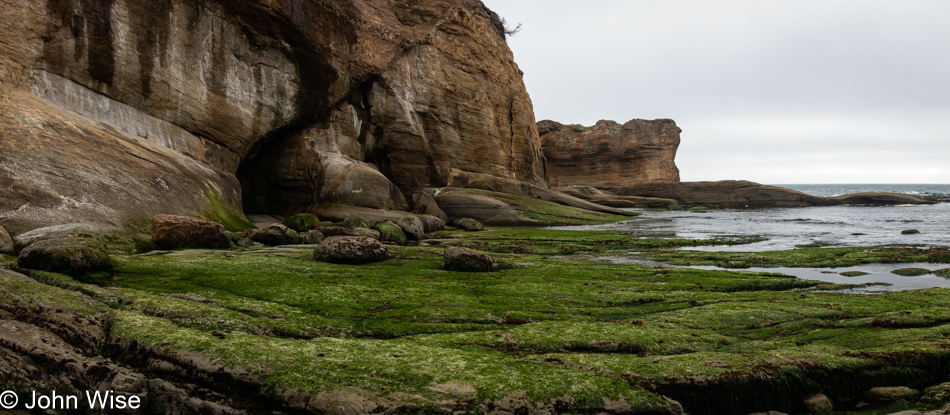
The workday is done, dinner has been had, and we’ve gone south to Devils Punchbowl Arch to evaluate if we want to be here on Saturday when the maximum negative tide will occur. With little in the way of tide pools, we agree that the need to enter the punchbowl is negligible and that we enjoy exploring tidal creatures and their environments more than exposed rock features.
Late addition: a week ago, when I first wrote this post, I excluded a bit of our experience here, as it felt too incredible to believe. After Caroline and I had already walked out over these rocks and tried peering into the cave-like openings before also checking if a path was open to walk around the corner and into the punchbowl, the tide wasn’t out and low enough, so we started on the way back. Just after taking this photo, a young couple walked up, and we explained the situation and recommended that maybe they wanted to return the next day during the lowest part of the expected negative tide. The young man believed he might find a way around the corner, so Caroline, myself, and his girlfriend stood talking and watched him go further than we had before he, too, realized there was no way to enter the punchbowl. On his way back, in a split second, a boulder from above was careening down, and the three of us screamed at the guy to start running – NOW! As he began sprinting, the three of us noticed a guy above who started running away, too, the guy who rolled the boulder off the cliff. There was no way he could have seen anyone below from his angle as he’d have had to hang over the side, but the foolishness of his stupidity was so incredibly explosively large, and the boulder was so close to having killed a person we were shocked. I can be seriously happy that Caroline and I weren’t still out there as nobody would have been nearby to yell at us to run away.
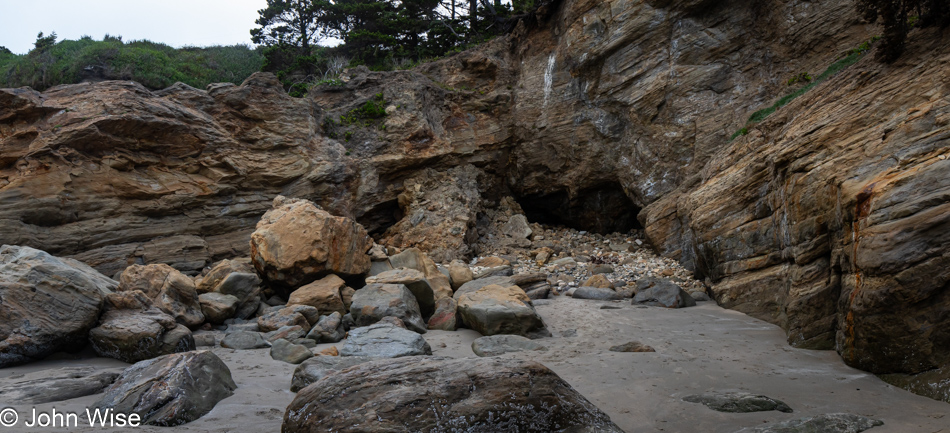
The beach on the north side of Punchbowl is very short, while the one here on the south side…
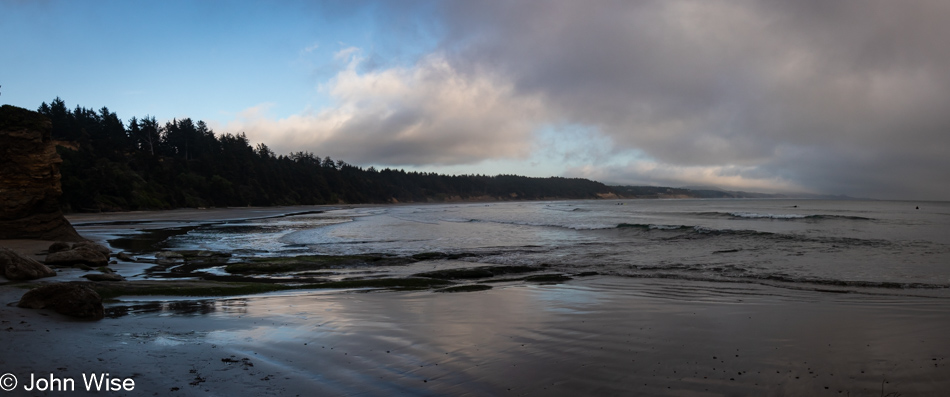
…is quite long. In the far distance, about halfway down the shore, is the Beverly Beach State Park. Beyond that, we could see the Yaquina Head Lighthouse, but the photo at this resolution can’t resolve it.

The one interesting find down here was a log that had washed up and was pretty rank-smelling. These are supposedly gooseneck barnacles, but if they are, they are either ancient or something has been misidentified because they do not look like the ones we’ve seen nearshore.
The visitors of your area, in voluntary cooperation with the Federal, State, and local authorities, have developed this system to keep you informed in the event of an emergency. If this had been an actual emergency, an official message would have followed the alert tone. This concludes this test of the Emergency Broadcast System.